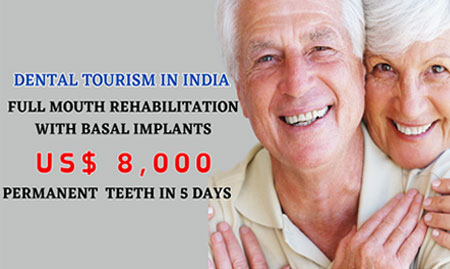Keywords:
Maxillary defect, Oral mucormycosis, Prosthetic reconstruction, Surgical rehabilitation, Zygomatic implants
1: Introduction
Oral mucormycosis, an opportunistic fungal infection caused by Mucorales species, is frequently observed in individuals with diabetes mellitus, immunosuppression, or post-COVID-19 complications. The infection propagates rapidly, resulting in widespread tissue necrosis, primarily affecting the maxillofacial region. Standard management includes aggressive surgical debridement and antifungal therapy.
However, the resulting maxillary defects pose a significant challenge for functional and aesthetic rehabilitation. In cases of severe maxillary bone loss, zygomatic implants are a reliable alternative to bone grafting, offering prosthetic support. A triple zygomatic implant configuration has emerged as a novel approach for comprehensive reconstruction in complex cases.
This report details a successful rehabilitation of a patient with post-mucormycosis maxillary defect using triple zygomatic implants.
2: Case Presentation
A 54-year-old male with a history of poorly controlled diabetes mellitus presented at LBR Dental and Implant Center with facial swelling, nasal regurgitation, and palatal ulceration. Clinical findings revealed necrotic tissue and black eschar in the maxillary region.
He underwent maxillectomy under general anesthesia, resulting in maxillary dentition loss, which affected both function and appearance. Histopathological examination and fungal culture confirmed invasive oral mucormycosis. A pre-operative orthopantomogram (OPG) revealed severe maxillary bone destruction, involving the maxillary sinus and palatal perforation (Figure 1).
Due to insufficient support for a surgical template, a freehand surgical procedure was performed. One year post-surgery, no provisional prosthesis was placed. The patient reported difficulty in chewing and nasal regurgitation, affecting function and aesthetics.
A provisional prosthesis was provided, followed by a fixed implant-supported prosthesis after 12 weeks of healing.
Triple zygoma implants were placed:
- 3 Zygomatic Implants: 45 × 4.2 mm, 40 × 4.2 mm, 37.5 × 4.2 mm
- 1 Cortical Implant: 16 × 4 mm
- 1 Pterygoid Implant: 18 × 4.2 mm
(All from Bioline Medical Dental Implant Solutions)
Multiunit abutments were connected.
A 3D-printed titanium framework (Figure 2) was fabricated using CAD-CAM technology. Zirconia teeth were placed on the titanium bar, achieving functionality and aesthetic appeal (Figure 3).
Post-operative OPG (Figure 4) showed well-anchored zygomatic implants, with no sinus involvement, implant mobility, or peri-implant radiolucency. The patient demonstrated improved mastication, speech, and facial aesthetics. A 6-month follow-up confirmed stable prosthesis retention.
CBCT-guided, minimally invasive zygomatic implant placement ensured primary stability with no complications post-operatively.
3. Discussion
Zygomatic implants are an established solution for maxillary reconstruction in patients with severe bone loss, especially in post-Mucormycosis cases. The triple Zygoma approach offers:
- Reinforced support
- Improved functional outcomes
- Reduced treatment time
- Avoidance of bone grafting
Strategic implant placement ensures even load distribution, preventing implant overload. Preoperative planning with advanced imaging plays a vital role in successful outcomes.
Unlike natural teeth, implants lack proprioception, which affects biomechanics. Zygoma implants, by achieving bi-cortical anchorage in the malar bone, are ideal in complete maxillary defects.
Final prosthesis was screw-retained with 20 Ncm torque. Occlusion adjustments were done, and regular recalls scheduled.
4. Conclusion
Zygomatic implants—particularly in a triple configuration—represent a reliable and efficient solution for patients with maxillary defects due to oral mucormycosis. This method avoids bone grafting, reduces treatment duration, and improves patient satisfaction, making it a potential gold standard for such reconstructions.




